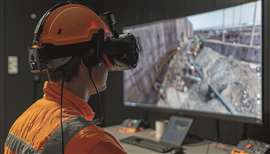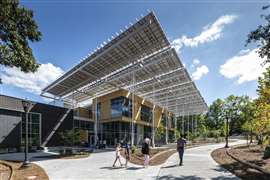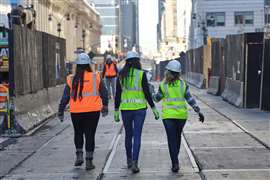Q&A with Skanska USA’s Scott Cannon on construction’s skills shortage
01 November 2024
Scott Cannon, executive vice president and general manager for Skanska Building operations in Atlanta, Georgia, US, discussed the value of internship programmes.
 Scott Cannon (Image: Skanska)
Scott Cannon (Image: Skanska)
More construction workers are needed every day in the US, but there are legitimate concerns in the industry that the recruiting and retention ecosystems are falling short of the country’s needs.
As a result, more firms are implementing and revamping apprenticeship and internship programmes to better engage the country’s young professionals.
Cannon shared his thoughts on Skanska’s intern programme with Construction Briefing as well as reflecting on his own time as a Skanska intern more than two decades ago.
Can you explain your relationship with the Skanska internship programme?
I’m Scott Cannon, general manager for Skanska USA Building’s Georgia operations, based in Atlanta.
I started my career in construction as a Skanska intern in the early ‘90s when we were known as Beers Construction. Since I went through the internship experience, I can appreciate the impact of our program. I’m really engaged with our internship program and still join our recruiters at career fairs when my schedule permits and often share with potential and current interns how what we do at Skanska can shape the future of their careers in construction.
This year, we had 195 interns across all Skanska business units in the US. [Of those], 155 interns are from USA Building, making it the largest cohort ever for Skanska USA Building.
What’s the single most important part of the internship programme? What makes it so vital?
Students learn a lot in their classroom curriculum, but nothing really compares to the in-depth, hands-on experience of a construction site. Being onsite and putting the theoretical knowledge from the classroom into practice allows our interns to understand the complexities and challenges of construction firsthand. We strive to give our interns a real perspective of what a career in construction will be like after college.
With that in mind, we’ve made a concerted effort to connect our interns across business units, nationally and internationally, over the last couple of years. We hold a virtual Fika call with our Swedish interns and a networking and project highlight call with our US and United Kingdom interns.
Our goal is to give our interns a feel for what it’s like to work at Skanska and knowing you can reach out to your colleagues across the country or across the world is part of that experience.
What’s different about today’s internship programmes?
 A construction worker uses virtual/augmented reality in a remote location. (Image: Adobe Stock)
A construction worker uses virtual/augmented reality in a remote location. (Image: Adobe Stock)
The advancement and adaptability of technology is a big difference from 20 years ago.
The virtual connection we offer our interns with our teams in the Nordics and Europe wasn’t a possibility on the scale that we can provide today. When it comes to the day-to-day job, when I was an intern, we didn’t have technology like Procore to aid in solving things quickly. We had to call someone and go to the construction site to find them if they didn’t answer.
I remember in my first bid room, project executives were discussing if we could afford to have a fax machine on the project.
With the evolution of technology and how we work in the industry, today’s interns can seek out and receive information much easier and faster. Although, this convenience can come at the cost of critical face-to-face communication, which we had more of 10-20 years ago.
Another assessment of our current interns is their ability to multitask — it far exceeds the interns of 10 and 20 years ago. We have an intern who will work remotely in a project engineering capacity for six to ten hours a week when he returns to college this fall. The advancement of technology makes it possible for our teams to adapt to this option for work and allows our interns to continue to get that real-world experience in a way that wasn’t available in the past.
What future innovations to intern programmes would be valuable?
We continue to see the need to recruit employees who have non-traditional degrees such as business, data, technology, marketing and others. Just this past year, we hired our first data scientist.
Training these employees to serve their specific role is important, but they also have a general understanding of our business and the construction industry. I can see future innovations helping to bridge that gap in knowledge and understanding.
Any final thoughts and comments?
 The Kendeda Building at Georgia Institute of Technology in the US. It’s said to be the 28th “Living Building” constructed in the world. (Image: Kendeda Building)
The Kendeda Building at Georgia Institute of Technology in the US. It’s said to be the 28th “Living Building” constructed in the world. (Image: Kendeda Building)
I don’t think people outside of our industry make the connection between construction and STEM [science, technology, engineering, mathematics].
Yes, engineering is the ‘E’, but exposing more students to how engineering applies to construction is key. There has been a big push to get more people interested in STEM degrees, but we need more awareness of construction as a STEM career path.
There aren’t many other careers where you can see and experience a tangible product from all your hard work. I built the hospital where my daughter was born as a preemie, and the NICU [neonatal intensive care unit] where she was treated until she was strong enough to come home.
I built the first ‘Living Building’ in the Southeast, the 28th in the world, for my alma mater, Georgia Institute of Technology. To play a part in building this living laboratory means so much to me, professionally and personally.
It makes Skanska’s core value of building for a better society come alive.
STAY CONNECTED



Receive the information you need when you need it through our world-leading magazines, newsletters and daily briefings.
CONNECT WITH THE TEAM








